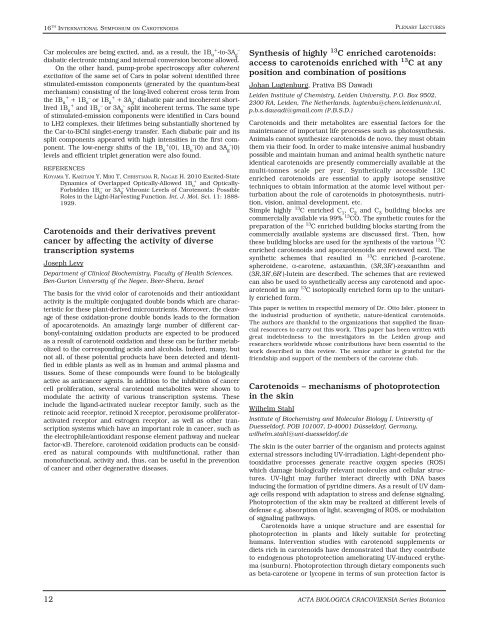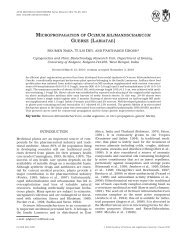ACTA BIOLOGICA CRACOVIENSIA
ACTA BIOLOGICA CRACOVIENSIA
ACTA BIOLOGICA CRACOVIENSIA
Create successful ePaper yourself
Turn your PDF publications into a flip-book with our unique Google optimized e-Paper software.
16 TH INTERNATIONAL SYMPOSIUM ON CAROTENOIDS<br />
+ –<br />
Car molecules are being excited, and, as a result, the 1Bu -to-3Ag<br />
diabatic electronic mixing and internal conversion become allowed.<br />
On the other hand, pump-probe spectroscopy after coherent<br />
excitation of the same set of Cars in polar solvent identified three<br />
stimulated-emission components (generated by the quantum-beat<br />
mechanism) consisting of the long-lived coherent cross term from<br />
+ – + – the 1Bu + 1Bu or 1Bu + 3Ag diabatic pair and incoherent short-<br />
+ – –<br />
lived 1Bu and 1Bu or 3Ag split incoherent terms. The same type<br />
of stimulated-emission components were identified in Cars bound<br />
to LH2 complexes, their lifetimes being substantially shortened by<br />
the Car-to-BChl singlet-energy transfer. Each diabatic pair and its<br />
split components appeared with high intensities in the first com-<br />
+ – – ponent. The low-energy shifts of the 1Bu (0), 1Bu (0) and 3Ag (0)<br />
levels and efficient triplet generation were also found.<br />
REFERENCES<br />
KOYAMA Y, KAKITANI Y, MIKI T, CHRISTIANA R, NAGAE H. 2010 Excited-State<br />
+<br />
Dynamics of Overlapped Optically-Allowed 1Bu and Optically-<br />
– –<br />
Forbidden 1Bu or 3Ag Vibronic Levels of Carotenoids: Possible<br />
Roles in the Light-Harvesting Function. Int. J. Mol. Sci. 11: 1888-<br />
1929.<br />
Carotenoids and their derivatives prevent<br />
cancer by affecting the activity of diverse<br />
transcription systems<br />
Joseph Levy<br />
Department of Clinical Biochemistry, Faculty of Health Sciences,<br />
Ben-Gurion University of the Negev, Beer-Sheva, Israel<br />
The basis for the vivid color of carotenoids and their antioxidant<br />
activity is the multiple conjugated double bonds which are characteristic<br />
for these plant-derived micronutrients. Moreover, the cleavage<br />
of these oxidation-prone double bonds leads to the formation<br />
of apocarotenoids. An amazingly large number of different carbonyl-containing<br />
oxidation products are expected to be produced<br />
as a result of carotenoid oxidation and these can be further metabolized<br />
to the corresponding acids and alcohols. Indeed, many, but<br />
not all, of these potential products have been detected and identified<br />
in edible plants as well as in human and animal plasma and<br />
tissues. Some of these compounds were found to be biologically<br />
active as anticancer agents. In addition to the inhibition of cancer<br />
cell proliferation, several carotenoid metabolites were shown to<br />
modulate the activity of various transcription systems. These<br />
include the ligand-activated nuclear receptor family, such as the<br />
retinoic acid receptor, retinoid X receptor, peroxisome proliferatoractivated<br />
receptor and estrogen receptor, as well as other transcription<br />
systems which have an important role in cancer, such as<br />
the electrophile/antioxidant response element pathway and nuclear<br />
factor-κB. Therefore, carotenoid oxidation products can be considered<br />
as natural compounds with multifunctional, rather than<br />
monofunctional, activity and, thus, can be useful in the prevention<br />
of cancer and other degenerative diseases.<br />
PLENARY LECTURES<br />
Synthesis of highly 13C enriched carotenoids:<br />
access to carotenoids enriched with 13C at any<br />
position and combination of positions<br />
Johan Lugtenburg, Prativa BS Dawadi<br />
Leiden Institute of Chemistry, Leiden University, P.O. Box 9502,<br />
2300 RA, Leiden, The Netherlands, lugtenbu@chem.leidenuniv.nl,<br />
p.b.s.dawadi@gmail.com (P.B.S.D.)<br />
Carotenoids and their metabolites are essential factors for the<br />
maintenance of important life processes such as photosynthesis.<br />
Animals cannot synthesize carotenoids de novo, they must obtain<br />
them via their food. In order to make intensive animal husbandry<br />
possible and maintain human and animal health synthetic nature<br />
identical carotenoids are presently commercially available at the<br />
multi-tonnes scale per year. Synthetically accessible 13C<br />
enriched carotenoids are essential to apply isotope sensitive<br />
techniques to obtain information at the atomic level without perturbation<br />
about the role of carotenoids in photosynthesis, nutrition,<br />
vision, animal development, etc.<br />
Simple highly 13C enriched C1 , C2 and C3 building blocks are<br />
commercially available via 99% 13CO. The synthetic routes for the<br />
preparation of the 13C enriched building blocks starting from the<br />
commercially available systems are discussed first. Then, how<br />
these building blocks are used for the synthesis of the various 13C enriched carotenoids and apocarotenoids are reviewed next. The<br />
synthetic schemes that resulted in 13C enriched β-carotene,<br />
spheroidene, α-carotene, astaxanthin, (3R,3R')-zeaxanthin and<br />
(3R,3R',6R')-lutein are described. The schemes that are reviewed<br />
can also be used to synthetically access any carotenoid and apocarotenoid<br />
in any 13C isotopically enriched form up to the unitarily<br />
enriched form.<br />
This paper is written in respectful memory of Dr. Otto Isler, pioneer in<br />
the industrial production of synthetic, nature-identical carotenoids.<br />
The authors are thankful to the organizations that supplied the financial<br />
resources to carry out this work. This paper has been written with<br />
great indebtedness to the investigators in the Leiden group and<br />
researchers worldwide whose contributions have been essential to the<br />
work described in this review. The senior author is grateful for the<br />
friendship and support of the members of the carotene club.<br />
Carotenoids – mechanisms of photoprotection<br />
in the skin<br />
Wilhelm Stahl<br />
Institute of Biochemistry and Molecular Biology I, University of<br />
Duesseldorf, POB 101007, D-40001 Düsseldorf, Germany,<br />
wilhelm.stahl@uni-duesseldorf.de<br />
The skin is the outer barrier of the organism and protects against<br />
external stressors including UV-irradiation. Light-dependent photooxidative<br />
processes generate reactive oxygen species (ROS)<br />
which damage biologically relevant molecules and cellular structures.<br />
UV-light may further interact directly with DNA bases<br />
inducing the formation of pyridine dimers. As a result of UV damage<br />
cells respond with adaptation to stress and defense signaling.<br />
Photoprotection of the skin may be realized at different levels of<br />
defense e.g. absorption of light, scavenging of ROS, or modulation<br />
of signaling pathways.<br />
Carotenoids have a unique structure and are essential for<br />
photoprotection in plants and likely suitable for protecting<br />
humans. Intervention studies with carotenoid supplements or<br />
diets rich in carotenoids have demonstrated that they contribute<br />
to endogenous photoprotection ameliorating UV-induced erythema<br />
(sunburn). Photoprotection through dietary components such<br />
as beta-carotene or lycopene in terms of sun protection factor is<br />
12 <strong>ACTA</strong> <strong>BIOLOGICA</strong> <strong>CRACOVIENSIA</strong> Series Botanica












